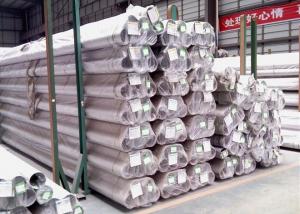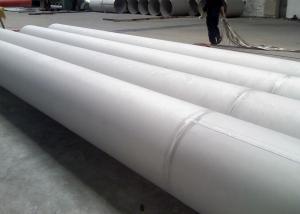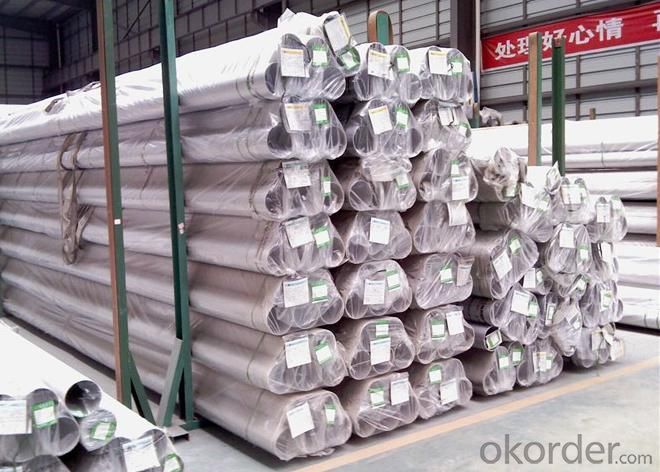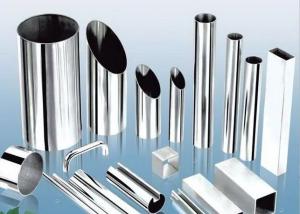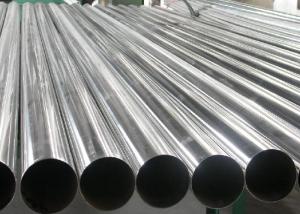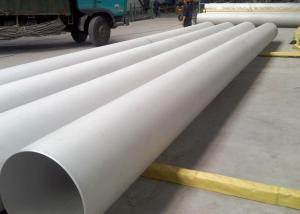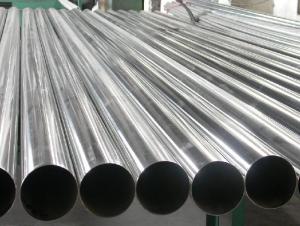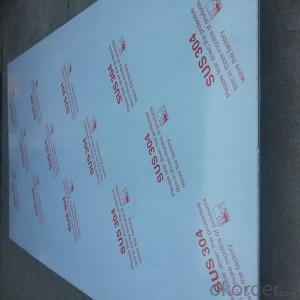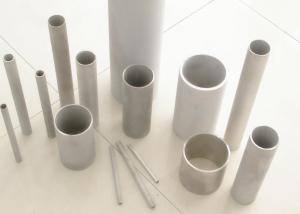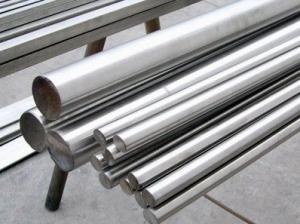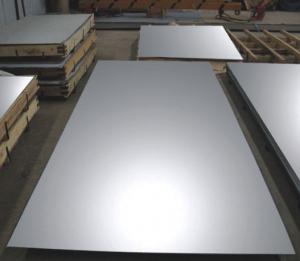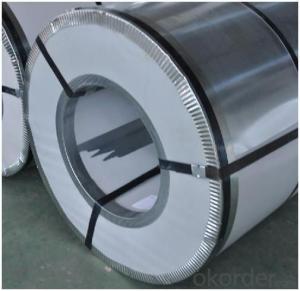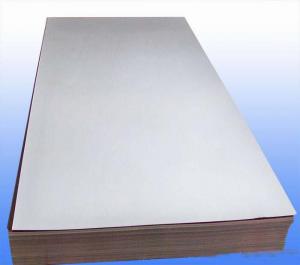304L Stainless Steel Welded Pipe
- Loading Port:
- China Main Port
- Payment Terms:
- TT or LC
- Min Order Qty:
- 5 Tons m.t.
- Supply Capability:
- 2000 Tons Per Month m.t./month
OKorder Service Pledge
OKorder Financial Service
You Might Also Like
Best Price For 304L Stainless Steel Welded Pipe
Application Of Best Price For 304L Stainless Steel Welded Pipe
Industrial Fluid Conveying
Boiler,Heat Exchanger and condenser
Sanitary and Thin-wall water pipe
Oil and Gas transportation etc.
Sizes Of Best Price For 304L Stainless Steel Welded Pipe
| OUTER DIAMETER | OD | WALL THICKNESS | |||
| SCH5S | SCH5S | SCH5S | |||
N.B | NPS | mm | mm | mm | mm |
8 | 1/4' | 13.72 | - | - | 2.24 |
10 | 3/8' | 17.15 | - | - | 2.31 |
15 | 1/2' | 21.34 | 1.65 | 2.11 | 2.77 |
20 | 3/4' | 26.67 | 1.65 | 2.11 | 2.87 |
25 | 1' | 33.4 | 1.65 | 2.77 | 3.38 |
32 | 1-1/4' | 42.16 | 1.65 | 2.77 | 3.56 |
40 | 1-1/2' | 48.26 | 1.65 | 2.77 | 3.68 |
50 | 2' | 60.33 | 1.65 | 2.77 | 3.91 |
65 | 2-1/2' | 73.03 | 2.11 | 3.05 | 5.16 |
80 | 3' | 88.9 | 2.11 | 3.05 | 5.49 |
90 | 3-1/2' | 101.6 | 2.11 | 3.05 | 5.74 |
100 | 4' | 114.3 | 2.11 | 3.05 | 6.02 |
125 | 5' | 141.3 | 2.77 | 3.4 | 6.55 |
150 | 6' | 168.28 | 2.77 | 3.4 | 7.11 |
200 | 8' | 219.08 | 2.77 | 3.76 | 8.18 |
250 | 10' | 273.05 | 3.4 | 4.19 | 9.27 |
300 | 12' | 323.85 | 3.96 | 4.57 | 9.52 |
350 | 14' | 355.6 | 3.96 | 4.78 | 11.13 |
400 | 16' | 406.4 | 4.19 | 4.78 | 12.7 |
450 | 18' | 457.2 | 4.19 | 4.78 | 14.27 |
500 | 20' | 508 | 4.78 | 5.54 | 15.09 |
550 | 22' | 558.8 | 4.78 | 5.54 | 15.09 |
600 | 24' | 609.6 | 5.54 | 6.35 | 17.48 |
650 | 26' | 660.4 | 5.54 | 7.92 | 17.48 |
700 | 28' | 711.2 | 5.54 | 7.92 | 17.48 |
750 | 30' | 762 | 6.35 | 7.92 | 17.48 |
800 | 32' | 812.8 | - | 7.9 | 17.48 |
850 | 34 | 863.6 | - | 7.92 | 17.48 |
900 | 36' | 914.4 | - | 7.92 | 19.05 |
1000 | 40' | 1016 | - | 9.53 | - |
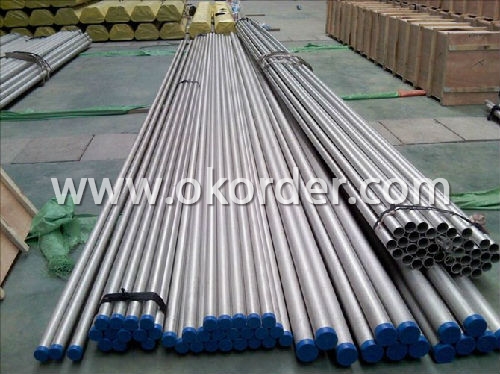
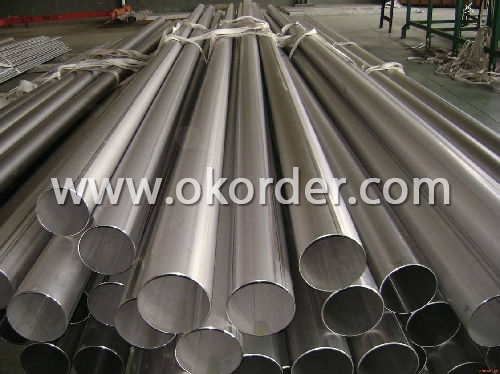
- Q: What are the pricing options for stainless steel sheets?
- The pricing options for stainless steel sheets can vary depending on factors such as the size, thickness, grade, and finish of the sheets. Generally, stainless steel sheets can range in price from around $30 to $300 per sheet.
- Q: What are the different types of stainless steel sheet edges?
- There are three main types of stainless steel sheet edges: mill edge, slit edge, and deburred edge. 1. Mill Edge: This is the most common type of stainless steel sheet edge. It is produced during the manufacturing process and is characterized by a rough, unfinished edge. The mill edge is typically straight and perpendicular to the surface of the sheet. It is suitable for most applications where a smooth edge is not required. 2. Slit Edge: Slit edge stainless steel sheets are created by cutting large rolls of stainless steel into narrower widths. The edges of these sheets are smoother and more precise compared to the mill edge. Slit edge sheets are commonly used in applications where a more polished and precise edge is needed, such as in architectural finishes or fabrication processes. 3. Deburred Edge: A deburred edge is achieved by removing any sharp or rough edges from the stainless steel sheet. This is done to enhance safety and prevent injury during handling or installation. Deburring can be done through various methods, such as grinding, sanding, or using specialized tools. The resulting edge is smooth and free from any burrs or sharp protrusions. It is important to note that the choice of edge type depends on the specific application and requirements of the stainless steel sheet. Each edge type has its own advantages and limitations, and it is crucial to consider factors such as aesthetics, functionality, and safety when selecting the appropriate edge for a particular project.
- Q: Can stainless steel sheets be used for backsplashes?
- Stainless steel sheets are indeed suitable for use as backsplashes. The reason why stainless steel is a popular option for this purpose is because it is durable, resistant to both heat and moisture, and requires minimal maintenance. Given that kitchen areas often experience high levels of heat and moisture, stainless steel is capable of withstanding these conditions, making it an ideal material for safeguarding walls behind stovetops and sinks. Moreover, stainless steel backsplashes can enhance the kitchen's appearance by providing a modern and sleek touch that complements various design styles. Additionally, cleaning stainless steel backsplashes is a breeze, as they can easily be wiped down using a damp cloth or cleaned with mild soap and water. All in all, stainless steel sheets are a practical and visually appealing choice for both residential and commercial backsplashes.
- Q: Are stainless steel sheets corrosion-resistant?
- Yes, stainless steel sheets are corrosion-resistant. Stainless steel is specifically designed to resist corrosion and staining, making it an ideal material for various applications. The high levels of chromium in stainless steel create a protective layer on the surface, which prevents rust and corrosion from forming. This makes stainless steel sheets suitable for use in environments where they may be exposed to moisture, chemicals, or other corrosive substances. Additionally, stainless steel sheets can withstand high temperatures and have excellent durability, further enhancing their corrosion-resistant properties.
- Q: Are stainless steel sheets resistant to heat and high temperatures?
- Stainless steel sheets possess exceptional resistance to heat and high temperatures. Their remarkable heat resistance properties enable them to maintain both their strength and structural integrity even under extreme temperature conditions. Consequently, stainless steel sheets are highly suitable for a diverse range of applications that involve heat and high temperatures. These applications include industrial furnaces, boilers, heat exchangers, and automotive exhaust systems. Stainless steel is capable of enduring temperatures of up to 1200 degrees Celsius (2192 degrees Fahrenheit) without compromising its structural properties, rendering it a favored option in industries requiring materials that can withstand intense heat. Furthermore, stainless steel also exhibits excellent resistance to oxidation, thereby preventing the formation of rust or scale when exposed to high temperatures for extended durations. In sum, stainless steel sheets serve as an exceptional choice for applications necessitating resistance to heat and high temperatures.
- Q: What is the corrosion resistance of stainless steel sheets?
- The high corrosion resistance properties of stainless steel sheets are well-known. This is because the alloy contains chromium, which creates a protective oxide layer on the steel's surface. This oxide layer acts as a barrier, preventing oxygen and moisture from reaching the steel underneath. Consequently, stainless steel sheets exhibit remarkable resistance to rust, staining, and corrosion in different environments, including exposure to water, chemicals, and extreme temperatures. The level of corrosion resistance can vary depending on the grade and composition of the stainless steel. In general, higher chromium and nickel content result in better corrosion resistance. Therefore, stainless steel sheets are extensively utilized in industries like construction, automotive, and food processing, where durability and resistance to corrosion are of utmost importance.
- Q: Can stainless steel sheets be used in food processing?
- Yes, stainless steel sheets can be used in food processing. Stainless steel is a common material used in the food industry due to its many beneficial properties. It is highly resistant to corrosion, which is crucial in food processing environments where frequent contact with water, chemicals, and food is expected. Stainless steel sheets are also non-reactive, meaning they do not interact with food or affect its taste, making it a safe choice for food processing equipment. Additionally, stainless steel is easy to clean and maintain, making it suitable for maintaining high levels of hygiene required in food processing facilities. Its durability and strength also ensure that it can withstand the rigorous demands of food processing operations. Overall, stainless steel sheets are a preferred material in the food industry due to their suitability for food processing applications.
- Q: What are the advantages and disadvantages of net drawing stainless steel users?
- Brushed stainless steel refers to: stainless steel surface like filamentous texture, this is only a stainless steel processing technology. The surface is Matt, and carefully look at the above there is a trace of texture, but can not touch it.
- Q: Do stainless steel sheets require any special maintenance?
- Stainless steel sheets do not require any special maintenance, but they do need regular cleaning to maintain their appearance and prevent corrosion. Unlike other materials, stainless steel is resistant to staining, rust, and corrosion, making it relatively low-maintenance. However, it is important to clean stainless steel sheets regularly to remove dirt, debris, and fingerprints that can diminish their shine. To clean stainless steel sheets, simply use a soft cloth or sponge with mild soap and warm water, avoiding abrasive cleaners or scrub brushes that can scratch the surface. Additionally, it is recommended to dry the sheets thoroughly after cleaning to prevent water spots or marks. By following these simple cleaning instructions, stainless steel sheets can maintain their beauty and functionality for years to come.
- Q: Can stainless steel sheets be used for food packaging or containers?
- Yes, stainless steel sheets can be used for food packaging or containers. Stainless steel is a widely used material in the food industry due to its many desirable properties. It is corrosion-resistant, which ensures that the food will not react with the container and remain safe for consumption. Stainless steel is also highly durable, making it suitable for long-term use in food packaging or containers. Additionally, it is easy to clean and maintain, ensuring proper hygiene standards are met. Stainless steel containers or packaging can also withstand extreme temperature changes, making them suitable for various food storage and transportation needs. Overall, stainless steel sheets are a reliable and safe choice for food packaging or containers.
1. Manufacturer Overview
| Location | Zhejiang,China |
| Year Established | 2000 |
| Annual Output Value | Above US$8.3 Million |
| Main Markets | Europe, America |
| Company Certifications | ISO9001:2000 |
2. Manufacturer Certificates
| a) Certification Name | |
| Range | |
| Reference | |
| Validity Period |
3. Manufacturer Capability
| a) Trade Capacity | |
| Nearest Port | Shanghai |
| Export Percentage | 30% |
| No.of Employees in Trade Department | 30 People |
| Language Spoken: | English;Chinese |
| b) Factory Information | |
| Factory Size: | Above 80,000 square meters |
| No. of Production Lines | Above 7 |
| Contract Manufacturing | OEM Service Offered;Design Service Offered |
| Product Price Range | Average |
Send your message to us
304L Stainless Steel Welded Pipe
- Loading Port:
- China Main Port
- Payment Terms:
- TT or LC
- Min Order Qty:
- 5 Tons m.t.
- Supply Capability:
- 2000 Tons Per Month m.t./month
OKorder Service Pledge
OKorder Financial Service
Similar products
Hot products
Hot Searches
Related keywords
